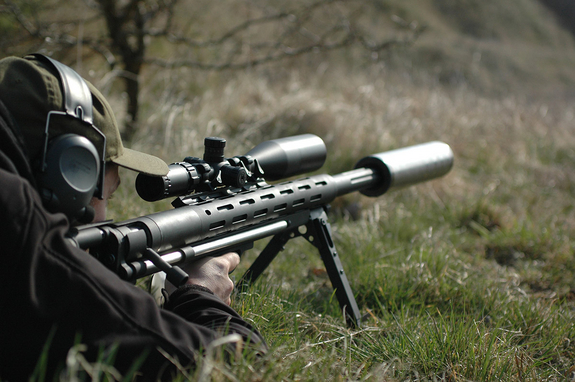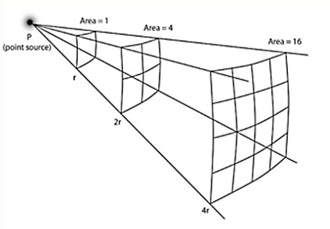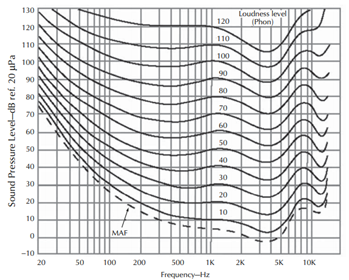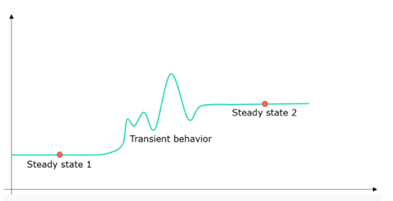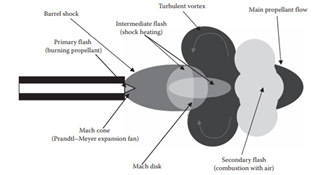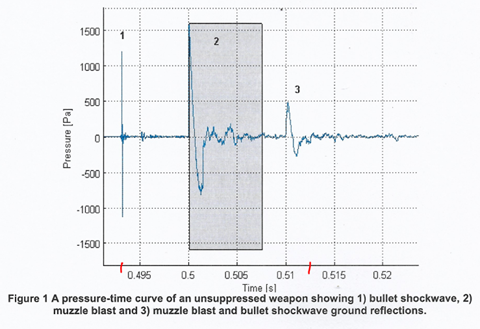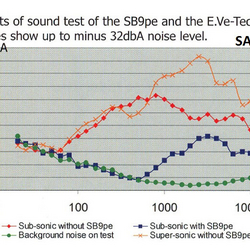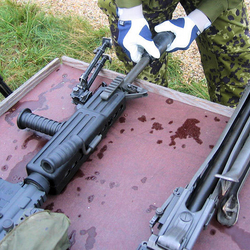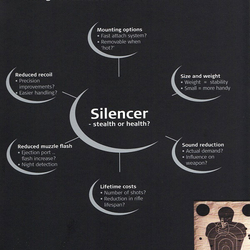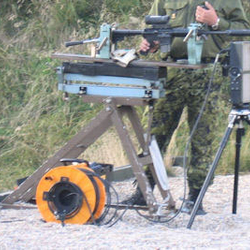The sound from a firearm is in fact a combination of the following five sounds:
- The powder gases leaving the barrel
- The supersonic boom of the bullet
- The mechanical sound from the firing action
- The bullet flying through the air
- The bullet impacting the target (Ambient effects, such as echo also affect the perception of sound)
Compared with many animals, the human ear is relatively undeveloped. This means that our ability to detect sounds is relatively limited. Long-term exposure to noise and age also affect the ability to detect sounds, and to varying degrees we are also affected diffrerently by different sound frequencies. Ambient weather conditions and the type of terrain the shooter finds themself in also affect the perceived sound, sometimes quite radically.
What sound can sound suppressors reduce?
If we analyse the five sounds listed above, the loudest sound produced by the firing of a firearm is that of the powder gases escaping the barrel – which is precisely what a sound suppressor is able to reduce.
As well as suppressing sound, a sound suppressor also significantly reduces recoil and muzzle blast, which has a positive effect on the shooter's aiming accuracy.
Are there any disadvantages to using a sound suppressor?
There are many benefits to using a sound suppressor, though it’s also important to understand what other factors come into play when using a sound suppressor, namely impact shift, the need to recalibrate the sight, the added weight and length of the firearm, and the additional wear on full and semi automatic firearms due to increased pressure during repetition firing.
Key factors regarding sound:
Sound propagates like a wave motion. Sound waves can be described by their frequency, which is an expression of the number of waves per unit of time. The standard unit is 1 / second, which is also called Hertz [Hz]. A normal human ear can perceive sounds in the frequency range from 20Hz to approx. 20,000Hz.
It is crucial that sound has both a giver and a receiver. The emitter - Or the sound source, in our optics, is a firearm in operation, the receiver is the setup measuring equipment and the human ear.
A wavelength is the length measured from wave top to wave top. The wavelength is inversely proportional to the frequency, as the frequency can be calculated as the speed of sound divided by the wavelength.
Sound waves are also described by their strength, referred to as amplitude. The amplitude indicated the volumes, most often measured in bell or deci Bel [dB]
Basically, the dB differs from other standard units in that it is logarithmic. A Bel thus expresses the ratio of a physical quantity (noted in the munerator on the traction below) relative to a specified or implied reference level (noted in the denominator in the following mathematical expression)
In relation to sound pressure (Sound Pressure Level), the ability of the huan ear to perceive pressure changes is taken into account. The human ear can detect pressure changes of at least 20 µPa
Sound Pressure Level – Definition:
Where 10 indicates the conversion from Bel to decibel.
At a pressure of 20 µPa (p1 = 20 µPa) this equation sums 0 dB, which emphasizes the relationship between the definition of sound volume and the perception of the human ear.
The speed of sound in dry air at 20 deg. Celsius is 343 m/s.
Table values frequencies:
| Frequency/Hz | Wavelength/m |
|---|---|
| 20 | 17,150 |
| 31,5 | 10,889 |
| 63 | 5,444 |
| 125 | 2,744 |
| 250 | 1,372 |
| 500 | 0,686 |
| 1000 | 0,343 |
| 2000 | 0,172 |
| 4000 | 0,086 |
| 8000 | 0,043 |
| 16000 | 0,021 |
| 20000 | 0,017 |
Distribution of sound in free field
The sound propagates spherically in outdoor free surroundings, with reflection of the sound when the sound waves meet a geometry - Be it the surface, forest, trees, houses, etc. The surface nature of the geometry determines how and how much the sound is reflected.
Spherical propagation of sound
Mathematically speaking, a sound source in a free environment is considered as a sound from a point. This point expands spherically and is similar in all directions, assuming that there are no reflective objects and “nature” obstructing the spherical distribution. The intensity of the sound decreases as the distance to the sound source increases. This means that the area occupied by the energy of sound grows with increasing distance to the sound source.
If the sound pressure L1 is known at the distance r1 (radius) the sound pressure L2 at the distance r2 can be calculated using the following expression:
When the distance r2 is doubled in relation to r1 the sound reduction measured n SPL is as follows:
In free field surroundings the sound is thus reduced by 6 dB for each doubling of the distance to the sound source.
Not all sound and all noise sources can be considered as sound from a point. However, as far as sund from a firearm is concerned, this assumption holds true, as the sound on which it is interesting to measure is triggered in a limited geometry; The muzzle of the pipe, which can very reasonably be regarded as a point. In cases where the sound cannot be assumed to have a specific point of xxx, but is would be defined as many points it will not be considered as a spherical propagation, but as a cylindrical propagation. At a cylindrical propagation, the sound intensity (I) is reduced from I to I / 2 when the distance r1 is doubled to r2. The expression for sound intensity then looks as follows:
Cylindrical propagation sound points are thus reduced by 3dB when doubling the radial distance. An example of sound points with cylindrical propagation is traffic noise, jet engines, leaky pressure valves, etc. However, these dB indications should not be confused with the reduction of the perceived sound - which is a completely different quantity. Within psychoacoustics, the thesis is that perceived sound volume, which is measured in so-called "son", doubles resp. reduces by 50% when the sound pressure increases or decreases by 10dB.
Sound can be perceived as respectively point sound with spherical propagation and sound with many propagation points, as indicated in the previous section - Similarly, sound can be considered coherent; coherent - And incoherent; not coherent sound.
Going forward, however, we choose to name the sound as follows:
- Steady state sound - The coherent, continuous sound; including music, speech flow, noise from jet engines, noise from pressure nozzles and valves, traffic noise and machine noise
- Impulse-generated noise, where impulse-generated sound or noise covers the sound produced by shots, claps or by striking an application with another application - A hammer against a train wheel or a bolt, a drumstick against a drum rail, etc.
The expressions are taken from the theories and arithmetic rules around vibrations and dynamics and give a good indication of which theories can be laid down as explanatory models for the results obtained
Perception of sound:
Without going into too much detail on psychoacoustics, here are a few important considerations about the human ear's perception of sound. Sound measurement is about measuring or quantifying sound in relation to the human ear. It is about the "impact" of sound on the human ear. Purely academically, one can say that there is only sound if there is both a sender and a receiver. Maybe a philosophical consideration but nonetheless.
The strength of the sound is perceived differently at different frequencies.
One factor in assessing a sound is the subjective strength of the sound; How loud a given sound is perceived. The fact that something is "subjective" can put any arithmetic nerd or mathematical theorist down and give that person gray hair in the head. This is because the values used must be retrieved from tables based on experience and question rounds instead of a mathematical formula.
Generally speaking, the human ear can withstand a pulse pressure of 200Pa (Pascal) of medium frequency.
The term “dynamic range” abbreviated “DR” covers this experience-based limit value and is calculated as follows:
This impulse pressure is at the limit of what the human ear can withstand without being damaged.
However, sound pressure is not perceived equally in the different frequency ranges. Thus, low frequency sounds are perceived lower than sounds in the medium frequency range. The concept of this non-uniformity is called "loudness" and can be summed up by the following graphic representation in the corresponding figure:
The figure illustrates the non-uniformity in relation to the perception of sound pressure; The volume at different frequencies. The curves show how nonlinear the human ear's perception of sound is, both in terms of frequency and sound level. The unit for a given loudness level (a given curve in the diagram) is called a "phon". By definition, two different sine curves will have the same level of loudness, measured in phons, if they are perceived as having the same strength by an average young person without hearing damage.
As can be seen from the loudness curves in the figure on the previous page, the human ear is most sound sensitive at approx. 3000Hz. The low frequency ranges are perceived lower than in the medium frequency range. The average frequency range is the name for the frequency range from approx. 500 to approx. 5000 Hz.
The same applies to the high-frequency areas, ie. at frequencies above 5000Hz. Where the perception is the sound pressure; the volume is not perceived with the same loudness as the average frequency range.
Time – Or the time course of a sound also plays a role in the perception of sound, as the human ear cannot distinguish sound and reflections of these, received within a time span of 35 Milliseconds. This often occurs indoors, which is why sound played indoors is typically perceived as being louder than sound played outdoors. To compensate for these fluctuations in the perception of sound, weighted scales have been developed; dB (A) dB (B) as well as an unweighted scale. We at SAI will not use the term dB with these weighted scales, but only use the term dB in the context of SPL (Sound Pressure Level) as an expression of decibels and sound pressure.
Steady state sound versus impulse generated sound:
We will only look at gun firing noise as being impulse generated. Ie. Sound propagated with an abrupt beginning and with a great clarity from a welldefined point to time t. To time t+ the sound is settled.
In fluid mechanics, steady state based theorems is based on assumption that all flow conditions and properties are constant over time. The opposite is true for transient models, which are based on the theses, that the conditions in relation to pressure and temperatures in particular are changeable over time Are dynamic and impulse controlled.
The graph below illustrates this as follows:
A shot contains chemical reactions and explosive energies. It has an abrupt and distinct onset time with a high pressure with spherical expansion and high temperature fluctuations and pressure waves of ultra short duration. This can hardly be considered and simulated with valid results under steady state conditions. If one does this, there is a high probability that weapons, as well as add-on equipment, such as a sound suppressor, will be both too large and too heavy without the perceived sound reduction effect being significant.
Summary:
Where the sound reduction has the greatest effect is thus in the middle range area of the frequencies detectable by the human ear. This is the area, where the human ear is most affected by sound.
- Low frequencies below 500 Hz
- Middle frequency area where the human ear is most affected: 500 – 5000 Hz
- High frequency area above 5000 Hz
The area, where it is best to sound reduce is in the middle range frequency area, where the human ear is most sensitive to sound at approx. 3000Hz.
The spectre, where it is most important to suppress the sound pressure is in the middle frequency range. The frequency where the the human ear are most sentisive to sound pressure is at aprox. 3000Hz.
The term dB is used without weighting as an indication of a given sound pressure, expressed by SPL (Sound Pressure Level).
A 50% reduction of the perceived sound corresponds to a reduction of 10 dB for the entire frequency band.
The sound of gunshots is impulse generated noise and not steady state sound, that can be reduced using steady state based technologies. Theories based on steady state boundary conditions will not be used as an explanatory theory in relation to working with sound and sound reduction technology (ie. Interior in sound suppressors)
The gun shot in the exact moment when the bulet leaves the muzzle, can be illustrated as follows: (Picture originated from a book on weapon theory by Jacobson and Garlucci)
Measurements:
Software used for measurements in this documentation is developed using the criteria listed in the NATO Protocol (NATO standard AEP-4785. Edition A, version 1, from August 2016)
The following illustration is from that protocol:
This illustration shows a pressure-time curve of an unsuppressed weapon. The sound components of the projectile’ shock wave, the muzzle and the reflection from the surroundings settles in 0,02 seconds (From 0,4925 seconds to 0,5125 seconds).
The gray-shaded marking on the graph illustrated the part of the sound that can be influenced of a sound suppressor.
We at SAI have tested every known measuring method. To give you an idea of how complex our understanding of sound is, we have included test results involving our SAI COBRA line of pistol sound suppressor for a specific cartridge type under specific aerial conditions.
The graph shows frequency in Hz along the x-axis and sound exposure in dBa on the y-axis. Note that the frequency is exponential, meaning that around a 3 dB reduction results in a perceived reduction of 50%.
The task of a sound suppressor is to reduce the frequencies that affect the human ear most of all - we simply don’t experience sound in the lower and upper areas of the curves.
What You should consider
Modern sound measuring technology has far exceeded the human ear’s ability to determine the relative performance of the many different sound suppressors on the market today. Once you have defined your requirement, we therefore recommend trying out our products for yourself.
To the right we have included a summary of the types of things that you should consider when investing in a sound suppressor.
We are always on hand to assist with any questions you have relating to our product range.

